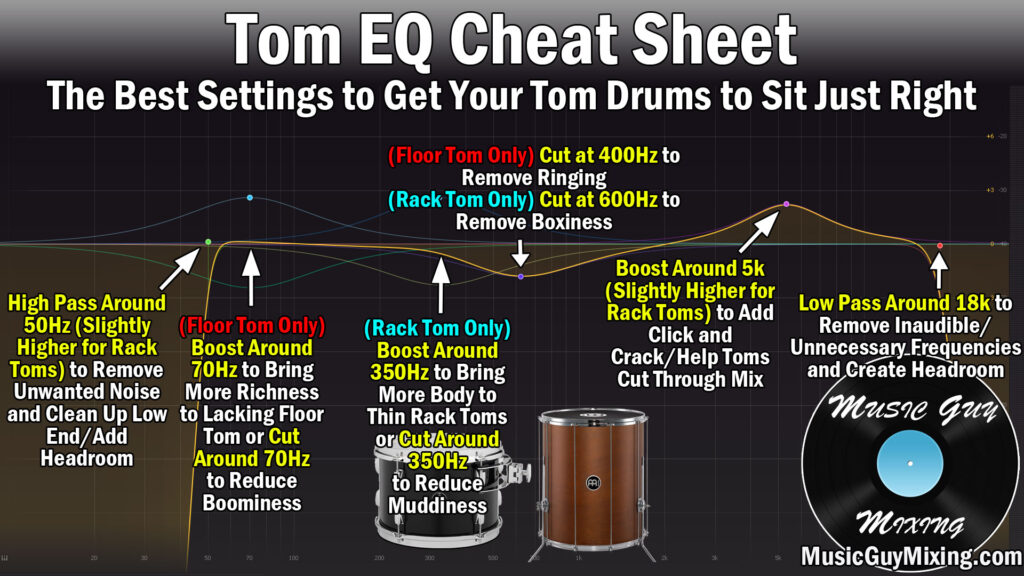Tom drums can be difficult to mix depending on how you have them recorded. Ideally you would have each tom (floor and individual racks) on their own tracks. Regardless, this guide will show you how to EQ tom drums to get them sitting perfectly in the mix.
How to EQ Tom
The tom drums have their fundamental rich frequencies in the low mids. Making a boost or cut can either bring out more of this richness, or reduce an overly boomy tom. Like the snare or kick, you can also help give them less or more attack by manipulating the upper mids. Let’s start by sharing my toms EQ cheat sheet.
Tom EQ Cheat Sheet
This toms EQ cheat sheet is meant to serve as a guide. Depending on your recording or samples, you may need to vary these frequencies slightly, and you’ll need to trust your ears to determine how much to cut (or boost).

Now I’ll address each frequency and recommendation so you have a better idea of what’s going on at each point.
Note that I used the FabFilter Pro-Q on that image and as my main EQ for its versatility and ability to dial in the sound I want quickly, but obviously any EQ is going to work with these tips. Now on to how to EQ tom drums!
High Pass Around 50Hz (Higher for Rack Toms)
I’m being conservative with these high pass targets so trust your ears, but we want to roll off the low end to create headroom, remove noise and unwanted frequencies, etc.
The largest floor toms can be tuned as low as 60Hz, though they typically reside a bit higher as I’ll discuss next. We want space for that kick which shares the same neighborhood. Thankfully the floor tom isn’t featured nearly as much in most drum tracks, so the two don’t step on one another that often.
Again, trust your ears for high passing on both the rack and floor toms and pay attention to that area with regards to the kick.
Boost/Cut 70Hz on Floor Tom
We’re starting to get into the rich fundamental frequencies of that floor tom low end around 70 or 80Hz. As such, you can boost if the tom feels lacking, or you can cut if the boominess is out of control. I won’t insult your intelligence by saying make sure you’ve got the level set correctly to get the floor tom to sit in the mix… but keep it in mind.
Boost/Cut 350Hz on Rack Tom
The fundamentals on the rack toms are more in the 200-500Hz area. Toms all come in different sizes with the larger ones have a lower fundamental frequency range. You’ve got to be flexible when you EQ tom drums for that very reason as it’s more grey than other instruments you’re going to EQ.
Cut at 400Hz to Remove Floor Tom Ringing Sound
Ugh that awful ringing sound on the floor tom. Try an EQ tom cut around 400Hz and see if that dampens that ringing sound. You might not be able to remove it completely without affecting the surrounding frequencies for the worse, but you can certainly mitigate its effect in the mix.
Cut at 600Hz to Remove Rack Tom Boxiness
I tend to find a lot of boxiness at 600Hz particularly on the rack toms. Again, your mileage may vary depending on the tuning and size of the tom, but I find a cut in this vicinity really opens things up. An EQ tom cut here places the emphasis on the lower fundamental and click of the rack tom, where it should be.
Boost Around 5k For Click (Higher on Rack Toms)
The click of stick on skin helps the toms cut through the mix and provides a bit of clarity. A boost in the 5k area usually works well on the floor tom.
Note that you might need to go a bit higher on the rack toms to the 7k, but sweep around until you find the loudest, cleanest part of that percussive click. I find soloing the tom and this frequency to be helpful.
Low Pass Around 18K
Another conservative pass filter; you can certainly go lower. Regardless, be sure to pass the top end of your toms in order to create space for your cymbals and, to a lesser extent, the vocals.
EQ Tom Tips
- Note that this is a rough EQ tom guide as compared to my usual EQ guides considering the range in frequencies different tom drums can occupy.
- High pass beginning at 50Hz and move up to create room for kick and remove unwanted frequencies (trust your ears).
- Boost or cut the floor tom around 70Hz or above to add richness or remove boominess.
- Boost or cut the rack tom around 350Hz to add body or remove muddiness.
- Cut the floor tom at 400Hz to reduce ringing.
- Cut the rack tom at 600Hz to remove boxiness.
- Boost floor tom around 5k (slightly higher for rack) to bring out more stick on skin crack and cut through mix.
- Low pass starting at 18k (conservative) to remove unnecessary frequency and open top end for cymbals and vocals.
